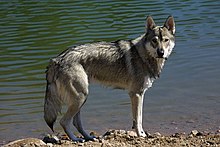Tamaskan Dog
| Tamaskan | |||||||||||||||||||||||||||||||||
|---|---|---|---|---|---|---|---|---|---|---|---|---|---|---|---|---|---|---|---|---|---|---|---|---|---|---|---|---|---|---|---|---|---|
 A Tamaskan dog | |||||||||||||||||||||||||||||||||
| Common nicknames | Tam, Tamaskan | ||||||||||||||||||||||||||||||||
| Origin | Finland | ||||||||||||||||||||||||||||||||
| |||||||||||||||||||||||||||||||||
| Notes | recognized ARBA Breed details | ||||||||||||||||||||||||||||||||
| Dog (domestic dog) | |||||||||||||||||||||||||||||||||
Tamaskan dogs are a Finnish dog breed cross-bred to resemble a wolf and wolfdog.[1] Although their exact origins are uncertain, these mixbreed dogs were primarily arctic breed crosses of Alaskan Husky, Alaskan Malamute, Canadian Eskimo Dog, German Shepherd, Labrador Husky, and Siberian Husky [2]. Tamaskans are not recognized as a breed by the Fédération Cynologique Internationale but are recognized as a breed by the American Rare Breed Association.[3] Pedigrees are only managed by Tamaskan-specific breeder clubs.[citation needed]
Description

Tamaskans are large, athletic dogs, and slightly taller than German Shepherds. With regard to build, they are substantially larger than typical sled dogs but smaller than the Alaskan Malamute.

On average, Tamaskan adults measure around 24-28 inches (60–70 cm) tall at the shoulder and typically weigh between 55-88 pounds (25–40 kg)–the heaviest recorded Tamaskan males (to date) weigh just under 50 kg. Females are usually slightly smaller and lighter than males, with a distinct feminine appearance. Males are more heavyset with broader heads and a heavier bone structure. Tamaskans have a lupine appearance with a straight bushy tail and thick double coat that comes in three main colors: wolf gray, red gray, and black gray. Each individual guard hair is agouti banded along its length. The almond-shaped eyes range from yellow through to amber and brown, with lighter colored eyes being very rare. Blue eyes are not acceptable, nor are mismatched eyes.[4]
Health

Overall, the Tamaskan variety is healthy; only a few notable health issues affect a small percentage of the bloodlines to date. Roughly 10% of males suffer from cryptorchidism: undescended testes. With these cases, usually only one testicle fully descends within the scrotum, while the other testicle remains "hidden" up within the abdominal cavity. Epilepsy has been diagnosed in five dogs, affecting about 1 out of every 100 registered Tamaskans worldwide. Several dogs have been found to be carriers of degenerative myelopathy. As with all large breed dogs, hip dysplasia is a risk.
History
In 2009, the Tamaskan Dog Register introduced a Saarloos Wolfdog as a single out-cross to bring some fresh blood into the breed. This particular Saarloos was specifically selected due to his temperament, appearance, and health.[5][unreliable source?]
Breed clubs
There are breed clubs in the United States (Tamaskan Dog Register), Canada (National Tamaskan Club of Canada), France (Club Français du Tamaskan), Germany (Tamaskan Club Germany), the Netherlands (Nederlandse Tamaskan Club), Croatia (Hrvatski Tamaskan Savez), and the United Kingdom (Tamaskan Dog Society of Great Britain).
Famous Tamaskan dogs

In October 2007, a Tamaskan named Genghis Khan featured as a wolf in a music video for the band Lucretia Choir.[6]
In September 2010, a TDR registered male Tamaskan named Wave became the official Live Mascot of North Carolina State University's football team: NC State Wolfpack. Wave (a.k.a. "Tuffy") now attends most home games and can be seen on the sidelines.[7][8][9][10]
In September 2012, four Tamaskans were featured on the Croatian HRT 1 television program Kućni ljubimci.[11]
In September 2015, a Tamaskan named Adler (White Elk Brighid) appeared in several news outlets including the Daily Mail, the Boston Times, and the Bark Post for mastering the game of Tug-of-War by using her mass instead of her strength.[12]
In 2016, a Tamaskan named Luchta (White Elk Luchta) appeared on Broadway. Luchta played the role of "The Wolf" in Arthur Miller's The Crucible produced by Scott Rudin and directed by Ivo van Hove.[13]
On September 19, 2017, Kaoru, a four-year-old therapy dog, was accompanied by her owner, another handler, and 10 other dogs on a hiking trail in Whistler, British Columbia, Canada. Kaoru provided support to many people, including children with autism. On the hike Kaoru was mistaken for a wolf by a hunter, who shot her at close range, killing her. [14]
See also
References
- ^ [1],
- ^ [2]
- ^ ARBA Group 5 gallery
- ^ "Tamaskan Pictorial Standard".
- ^ "The History of the Tamaskan Breed". Tamaskan-Dog. Retrieved 22 April 2016.
- ^ Paul Hornsey. "Lucretia Choir: News".
- ^ "Local & North Carolina state news from Raleigh, NC - NewsObserver.com". Archived from the original on 2010-12-02.
- ^ "The Daily Tar Heel :: N.C. State to Use Tamaskan Dog for Mascot".
- ^ "The Cutest Live College Mascots". PEOPLE.com.
- ^ "NC State's Live Mascot "Tuffy"".
- ^ "1156. Emisija "Kućni ljubimci", HTV 1, 22.09.2012. 10:10 sati - Facebook".
- ^ "Adler the dog takes the lazy route in tug-of-war against her furry friend ... by never getting up".
- ^ FOX (2016-06-14). "WATCH: Adorable dog stars is the hottest star on Broadway! - Story | WWOR". My9nj.com. Retrieved 2016-08-20.
- ^ http://www.news1130.com/2017/09/19/therapy-dog-mistaken-wolf-killed/
External links
- The Tamaskan Dog Register
- The Florida Lupine News Volume 9 Issue 3 (Autumn 2007) [unreliable source?]
- Das deutsche Hunde Magazin November 2011
